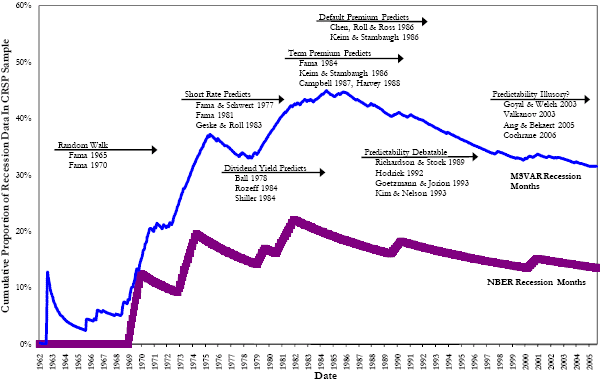When times are good, the powers that be (central banks for interest rates and corporate boards for payouts to shareholders) have more latitude to buffer reactions to changes in the business environment. Does this latitude make widely used indicators of future stock returns less useful, or useless, during expansions? In their June 2007 draft paper entitled “Short-Horizon Predictability and Information Erosion”, Sam James Henkel, Spencer Martin and Federico Nardari investigate how the predictability of equity market returns varies across the business cycle. They focus on the dividend yield, the short-term interest rate, the slope of the term structure and the default premium as predictors of stock returns. Using monthly data spanning April 1953 to December 2005 for the U.S. (634 months) and comparable data as available for Canada, France, Germany, Italy, Japan and the UK, they find that:
- The predictive power of the the selected indicators depends strongly on the business cycle. As the percentage of recession months in the data sample increases, so do discoveries of predictability.
- Specifically, in six of the seven countries analyzed, these indicators have substantially greater predictive power during recessions than during expansions.
- In the U.S., the adjusted R-squared describing the monthly predictive power of the indicators is less than 0.5% during expansions but as high as 18.9% during recessions. Essentially all of the predictive power in the full U.S. sample is contained within National Bureau for Economic Research (NBER) recessions.
- Changes in the correlations between the predictors and the equity risk premium across the business cycle drive the variability in predictive power.
The following figure, taken from the paper, illustrates how equity return predictability research findings vary with the expansion-recession mix within the data used. The violet and blue lines show the cumulative percentage of recessionary months in the frequently used Center for Research in Securities Prices (CRSP) database from inception in 1963. The violet line counts recessionary months based on recession start and end dates from NBER. The blue line counts recessionary months based on a regime-switching vector autoregression analysis described in the paper. The more (less) representation from recessionary months, the more (less) likely the researchers are to find predictive indicators. Specifically:
(1) The 1970s random walk model of unpredictable stock prices drew upon (uninformative) data from the long expansion of the 1960s.
(2) Research of the mid-1980s, incorporating (informative) data from several recessions, repeatedly found stock return predictability.
(3) Research of the 1990s, incorporating (uninformative) data from the long expansions of the 1980s and 1990s, reasserted doubt in return predictability.

In summary, because the most informed players have the latitude to delay showing their hands during business expansions, the power of widely used indicators of future stock returns emerges predominantly during recessions.
This research points out the difficulty of assembling samples long enough to support reliable inference when there is a dependence on the business cycle. Quality data does not exist for a large number of business cycles, and structural breaks in relationships among economic indicators complicate comparing one business cycle to another.